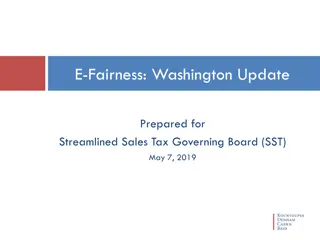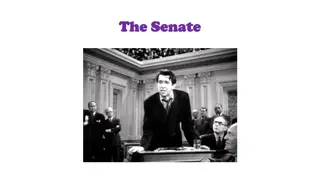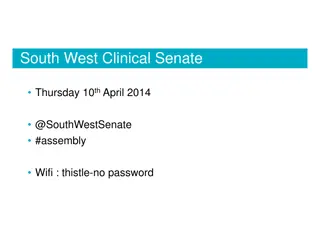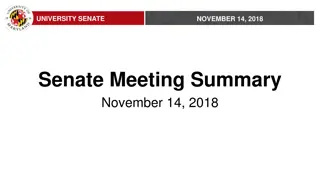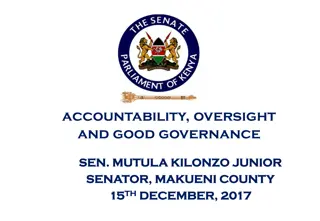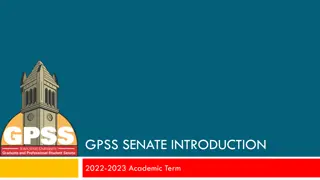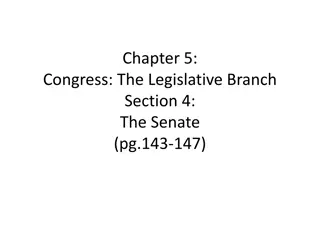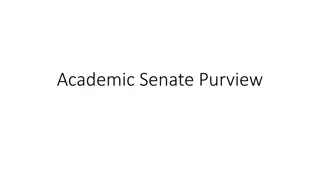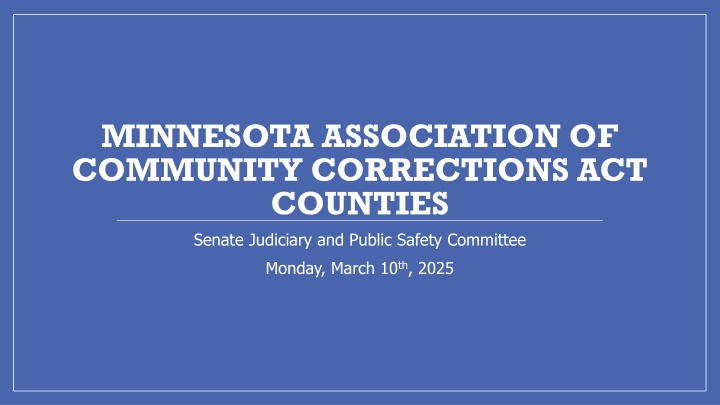
Community Corrections in Minnesota
Explore the role of the Minnesota Association of Community Corrections Act Counties in delivering evidence-based supervision to enhance public safety, reduce recidivism, and support rehabilitation in local communities. Learn about the various probation delivery systems in Minnesota and how funding is allocated to ensure equitable distribution for effective supervision.
Download Presentation

Please find below an Image/Link to download the presentation.
The content on the website is provided AS IS for your information and personal use only. It may not be sold, licensed, or shared on other websites without obtaining consent from the author. If you encounter any issues during the download, it is possible that the publisher has removed the file from their server.
You are allowed to download the files provided on this website for personal or commercial use, subject to the condition that they are used lawfully. All files are the property of their respective owners.
The content on the website is provided AS IS for your information and personal use only. It may not be sold, licensed, or shared on other websites without obtaining consent from the author.
E N D
Presentation Transcript
MINNESOTA ASSOCIATION OF COMMUNITY CORRECTIONS ACT COUNTIES Senate Judiciary and Public Safety Committee Monday, March 10th, 2025
What is MACCAC? The Minnesota Association of Community Corrections Act Counties represents the 28 CCA jurisdictions comprised of 40 counties that have elected to be responsible for providing all correctional field services to individuals on supervision in Minnesota. Our mission is to deliver high-quality, evidence-based supervision that enhances public safety, reduces recidivism, and supports rehabilitation in our communities.
Probation in Minnesota is centered on local choice and allowing local solutions. Minnesota has three probation delivery systems, each funded differently: Community Corrections Act (CCA) Services administered by counties. County Probation Officer (CPO) Services administered by a combination of county/state. Department of Corrections (DOC) Services administered entirely by the state via contract.
Prison 8% Minnesota relies heavily on probation to keep communities and Minnesotans safe Probation 92% 102,000 people were incarcerated, on probation or supervised release statewide in 2023.
CPO 7% Counties supervise the most probation cases in Minnesota CCA 75% DOC 18% State= 18% Counties = 82%
How the funding works The Community Supervision Funding Formula ensures equitable and needs-based distribution of state funding to counties. It is based on a capitated rate per supervised individual, ensuring resources align with actual workload and supervision intensity. Components of the Formula Base Allocation: Every county receives a minimum funding floor of $150,000 to support core supervision services. Capitated Rate: A felony and supervised release per diem rate of $5.62 is applied to determine funding based on the supervised population. Funding for gross misdemeanor, misdemeanor, and juvenile probation cases is calculated at 50% of the felony rate ($2.81 per client per day). Caseload & Workload Adjustments: Funding is based on the most recent caseload data, meaning annual fluctuations in client numbers impact funding levels year to year. Equity Adjustments: Corrects historical funding imbalances among counties.
How the funding works The capitated rate of $5.62 per day for felony supervision in Minnesota was established based on an analysis of Minnesota community supervision workload and comparisons to recent studies and reports from other states, intended to better represent the essential costs of effective supervision. To calculate this rate, a detailed workload study was conducted to assess the time and resources necessary for supervising individuals at various risk levels. The study considered the administrative costs of providing supervision and the average daily cost for supervising individuals, depending on their risk level. Based on current statute there is to be a regular workload study conducted by the commissioner of corrections to ensure the rate is reflective of the costs associated with supervision.
How the funding works Let's take Minnetown County, which supervises the following populations: Felony Supervised Population: 1,000 clients Gross Misdemeanor, Misdemeanor, and Juvenile Supervised Population: 500 clients Using the current capitated rate formula: Calculate Felony Supervision Funding: 1. 1,000 clients $5.62 per day = $5,620 per day 2. Annual total: $5,620 365 = $2,050,300 Calculate Misdemeanor, Gross Misdemeanor, and Juvenile Supervision Funding: 1. 500 clients $2.81 per day = $1,405 per day 2. Annual total: $1,405 365 = $512,825 Add Base Allocation: 1. $2,050,300 (Felony) + $512,825 (Other Populations) + $150,000 (Base Allocation) Total Funding for Minnetown County: 1. $2,713,125 per year
Funding Shortfall & Its Local Impact If a statewide funding shortfall of $$10,062,972 exists as it currently does in Minnesota today, Minnetown County will only be receiving an adjusted allocation based on their county s population in relation to the state s total population. Expected Funding: $2,713,125 Actual Prorated Funding: $2,535,192 Funding shortfall: $177,933 The loss of funding will result in the loss of 2-3 agents based on the average cost of employment of a corrections agent and/or reduction of available programming in Minnetown County. Minnetown County will face increased caseloads by shifting clients to existing agents, strain on existing staff, reduced resources for clients, less ability for agents to administer practices known to improve public safety.
How have counties and clients benefitted? Cognitive behavioral programs, risk assessments, case planning tools More time for high-risk individuals Lower caseloads High-risk caseloads More supervision staff hired Competitive salaries reduce turnover in hard to fill positions Investment in reentry housing Family reunification programs
What we know! The revised funding formula is already working, allowing counties to: Retain skilled supervision staff and hire more agents Reduce caseload sizes Expand evidence-based practices Implement specialized reentry programs Without full funding, these gains are at risk.
Supervision Fee Removal & Its Financial Impact In the same year the new funding formula was passed, the ability to assess supervision fees was removed statewide. The expectation was that this revenue loss would be fully offset by a fully funded supervision formula to maintain county operations. Without full funding and the loss of supervision fees, counties cannot sustain the progress made under the revised funding formula.
Supporting Successful Reentry Under MRRA The Minnesota Rehabilitation and Reinvestment Act (MRRA) will result in more individuals transitioning from incarceration to community supervision. Counties need resources to support reentry, including: Additional supervision staff Housing assistance and placement Mental health and substance use treatment Employment and vocational programs Without full funding, counties will be unprepared to manage the increased caseloads, threatening both successful reintegration and public safety.
WHAT CAN BE DONE? SF2120/HF1769 3-year averaging and fully funding the community supervision formula
Stabilizing Community Supervision Funding Stabilizing Community Supervision Funding Counties need predictable, stable fundingto plan effectively and maintain high-quality supervision services. 3-year averaging prevents disruptive funding fluctuations, allowing counties to: Retain experienced staff Maintain critical supervision programs Invest in long-term public safety strategies Without funding stability, counties may struggle to sustain best practices and essential staff to administer services
Investing in Community Supervision = Safer Communities Community supervision works and it must be fully funded to remain effective. The revised formula is proving successful, but continued investment is necessary to sustain progress and maximize cost savings. MACCAC is seeking legislative support of SF2120 to: Ensure public safety through stable, evidence-based supervision, which costs less than incarceration. Ensure adequate capacity for MRRA which will lead to increased reentry demands while reducing recidivism. Maintain innovative local programs that prevent costly future justice system involvement. We appreciate your partnership in strengthening Minnesota s community supervision system while ensuring smart, cost-effective public safety solutions.






